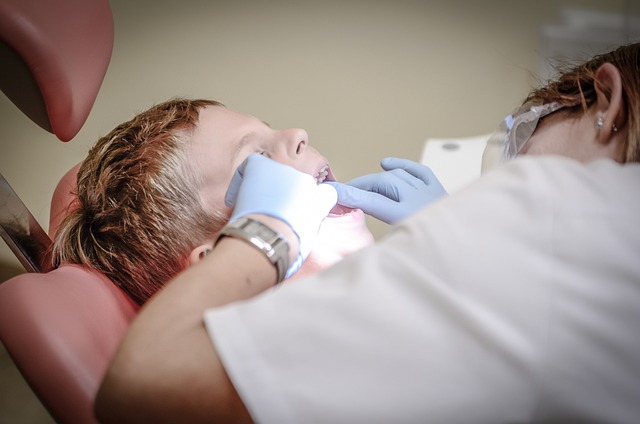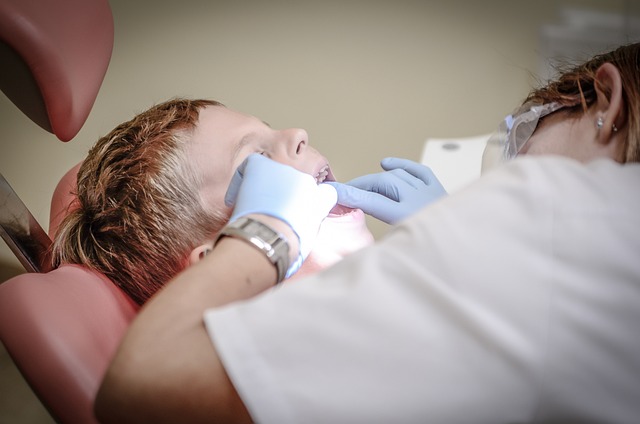Step-by-Step Guide: Changing Gauze After Tooth Extraction
Welcome to our step-by-step guide on changing gauze after tooth extraction! If you’ve recently undergone this dental procedure, you’re likely looking for some helpful advice on how to properly care for your healing mouth. Fret not, as we’ve got you covered. In this informative article, we’ll walk you through the process of changing your gauze, guiding you with easy-to-follow instructions and valuable tips along the way. So sit back, relax, and get ready to learn all you need to know about this vital aspect of post-extraction care. By the end, you’ll feel confident and empowered to take charge of your healing journey like a pro. Let’s get started!
1. Introduction: Why it’s important to change gauze after tooth extraction
After a tooth extraction, changing the gauze is a crucial step in the recovery process. It plays a significant role in ensuring proper healing and minimizing the risk of complications. Here’s why it’s important to change gauze after a tooth extraction:
Promotes blood clotting: Changing the gauze right after the procedure helps control bleeding. By applying a fresh piece of gauze to the extraction site, pressure is applied to the wound, encouraging the formation of a blood clot. This clot acts as a protective barrier, preventing excessive bleeding and keeping the area free from infection.
Prevents infection: Regularly changing gauze pads ensures the wound remains clean and free from bacteria. After a tooth extraction, the open socket can be prone to infection. By replacing the gauze, you minimize the risk of introducing harmful bacteria or debris into the wound. It also helps in absorbing any excess saliva or blood that may accumulate, maintaining proper hygiene and reducing the chances of infection.

2. Preparing for the gauze change: Gathering the necessary supplies
Gauze changes are an essential part of wound care that help promote healing and prevent infection. Before beginning the process, it’s important to gather all the necessary supplies to ensure a smooth and efficient change. Here’s a list of the items you’ll need:
- Gloves: Always wear gloves to protect both yourself and the patient from potential contamination.
- Gauze pads: Use sterile gauze pads to clean the wound and absorb any drainage or excess fluid.
- Tape: Secure the gauze in place using medical tape or adhesive strips. This helps keep the wound protected and prevents the gauze from shifting.
- Cleansing solution: Depending on the type of wound and its state of healing, you may need an appropriate cleansing solution, such as saline or an antiseptic.
- Tweezers: Having a pair of sterile tweezers can come in handy for removing any debris or foreign objects from the wound.
- Antibiotic ointment: Applying a thin layer of antibiotic ointment can help prevent infections and promote healing.
- Waste container: Prepare a lined waste container to safely dispose of used gauze, gloves, and any other contaminated materials.
By ensuring you have all these necessary items gathered and organized, you’ll be well-prepared for a successful gauze change. Remember, maintaining a clean and sterile environment is vital to wound care, so having the right supplies at your fingertips will help you provide the best care for the patient.

3. Step 1: Gently removing the old gauze pad
When it comes to taking care of wounds, one of the first steps in the process is gently removing the old gauze pad. This is a crucial step to ensure proper healing and prevent infection. Here are some tips to help you remove the old gauze pad safely:
- Wash your hands: Before touching the wound or removing the old gauze pad, make sure to wash your hands thoroughly with soap and water. This helps minimize the chance of introducing bacteria to the wound.
- Gently lift the edges: Start by holding the edges of the gauze pad and carefully lift it away from the wound. Avoid pulling it off forcefully, as it may stick to the wound and cause discomfort.
- Use a clean damp cloth: If the gauze pad seems to be stuck to the wound, you can moisten a clean cloth with warm water and gently dab it on the pad. This can help loosen it and make removal easier.
- Dispose of the old gauze pad: Once the old gauze pad is removed, place it in a plastic bag or wrap it in tissue. Make sure to dispose of it properly to prevent the spread of infection.
Remember, be gentle and take your time when removing the old gauze pad to avoid causing any unnecessary pain or harm to the wound. If you notice excessive bleeding, signs of infection, or have any concerns, consult a healthcare professional for further guidance.

4. Step 2: Rinsing your mouth with saltwater solution for cleanliness
To ensure cleanliness and promote healing, rinsing your mouth with a saltwater solution is an essential step in your oral care routine. Saltwater has natural antibacterial properties that can reduce inflammation, fight off harmful bacteria, and assist in quick recovery.
To create your saltwater solution, simply mix half a teaspoon of salt with 8 ounces of warm water. Use lukewarm water as extreme temperatures can be uncomfortable. Stir the mixture until the salt is completely dissolved. Then, follow these easy steps to effectively rinse your mouth:
- Take a small sip of the saltwater solution.
- Gently swish the liquid around in your mouth for 30 seconds.
- Slightly tilt your head backward to reach the back of your throat without swallowing.
- Spit the solution out into the sink.
Remember, do not swallow the saltwater, as it may cause dehydration or upset your stomach. Rinse your mouth with the saltwater solution two to three times a day, especially after meals or when recommended by your dentist. This simple yet effective step will enhance cleanliness, aid in soothing any discomfort, and promote a healthy environment for your gums and mouth to heal.

5. Step 3: Choosing the right size of gauze for your wound
When it comes to choosing the right size of gauze for your wound, it’s important to consider the size and type of the wound. Here are some helpful tips to guide you:
- Assess the wound: Start by examining the size, depth, and location of the wound. This will help you determine the appropriate size of gauze needed.
- Choose the correct dimensions: Gauze typically comes in various sizes, such as 2×2 inches, 4×4 inches, and non-standard sizes as well. For smaller wounds or minor cuts, a 2×2-inch gauze pad should suffice. However, for larger wounds, opt for a 4×4-inch gauze pad or a size that can fully cover the area.
- Consider the drainage: The amount of wound drainage should also be taken into account. If the wound is oozing or bleeding heavily, a larger gauze pad may be necessary to properly absorb the fluid.
Remember, it’s always better to choose a slightly bigger size of gauze as you can easily trim it if needed, rather than having a pad that is too small for adequate coverage. By selecting the right size of gauze, you can provide proper wound care and promote faster healing.
6. Step 4: Placing the fresh gauze pad over the extraction site
Once the tooth extraction is complete, it is crucial to place a fresh gauze pad over the extraction site to promote proper healing and prevent any bleeding. Follow these simple steps to ensure you are taking care of your mouth after the procedure:
– Carefully remove the old gauze pad from your mouth, ensuring not to disrupt the area where the tooth was extracted. Gently discard the used gauze.
– Take a new and clean gauze pad and fold it in half for more effective coverage. This will help absorb any residual blood and protect the sensitive area.
– Position the folded gauze directly over the extraction site and apply gentle pressure by biting down softly. The pressure will promote the blood clotting process and aid in minimizing bleeding.
– Remember to replace the gauze pad every 30 to 45 minutes, or as directed by your dentist, to keep the area clean and facilitate faster healing.
Taking proper care of the extraction site is imperative for a smooth recovery. With the use of fresh gauze pads and regular replacement, you are ensuring cleanliness, preventing infection, and promoting a healthy healing process. Reach out to your dentist if you experience excessive bleeding or any other concerns during the recovery period. Remember, a restful and careful post-extraction routine will contribute to your overall oral health!
7. Step 5: Applying gentle pressure to control bleeding and promote healing
Once you have thoroughly cleaned the wound, the next step is to apply gentle pressure to control any bleeding and promote healing. This crucial step helps to stop further bleeding, prevent infection, and aid in the clotting process. Remember, always wash your hands before touching the wound or applying any pressure.
To start, take a clean cotton pad or sterile gauze and place it directly on the wound. Apply gentle but firm pressure using your fingers or hand, making sure not to push too hard to avoid causing more pain or damage. Keep the pressure applied consistently for at least 10 minutes, allowing the blood to clot.
- Do not remove the pad or gauze during this time, as it may disrupt the clotting process.
- Avoid peeking or checking the wound frequently, as this may interfere with the clot formation and re-introduce bacteria.
- If the bleeding doesn’t stop after 10 minutes, continue applying pressure and seek medical help if necessary.
- Never use a tourniquet unless it is a life-threatening situation, as this can restrict blood flow and cause more harm than good.
After the bleeding has ceased, you can now proceed with dressing the wound to protect it from further exposure and contamination. Remember to always consult a healthcare professional for any severe or persistent bleeding that you may encounter. Applying gentle pressure is a crucial step in promoting healing, preventing infection, and ensuring proper wound care.
8. Timing and frequency: How often should you change the gauze?
When it comes to changing the gauze after a surgical procedure or injury, timing and frequency play a crucial role in ensuring proper wound healing. While there is no one-size-fits-all answer to how often you should change the gauze, here are some general guidelines to follow:
- Monitor the wound: Keep a close eye on the wound and check for any signs of infection or excessive bleeding. If you notice any abnormal symptoms, consult your doctor immediately.
- Follow your doctor’s instructions: Your healthcare professional will provide specific instructions on how frequently you should change the gauze. It is essential to strictly adhere to these guidelines to promote optimal healing.
- Change it when it gets dirty or wet: It is recommended to change the gauze whenever it becomes soiled or wet with blood, drainage, or any other fluids. This helps reduce the risk of infection and promotes a clean healing environment.
- Consider the type of wound: The type and severity of the wound can also impact the frequency of gauze changes. Deeper or more complex wounds may require more frequent changes compared to superficial ones.
Remember, gauze serves as a barrier to protect the wound from dirt, bacteria, and further injury. By following these guidelines and staying attentive to your wound’s condition, you can ensure that your gauze is changed at the appropriate times, facilitating a faster and smoother recovery.
9. Potential complications and signs to look out for during gauze changes
While changing the gauze dressings after a dental surgery or oral procedure, it is important to keep an eye out for any potential complications or signs of trouble. Although most patients experience a normal healing process, it is essential to be aware of any unusual symptoms that may require further attention. Here are some common complications to watch for during gauze changes:
- Excessive bleeding: It is normal to experience some bleeding during the initial hours after a procedure. However, if bleeding appears excessive or does not subside after applying pressure, it may be a cause for concern. In such cases, contact your dentist immediately.
- Increasing pain or discomfort: Mild pain or discomfort are common after oral surgeries, but if these symptoms become increasingly severe or do not improve after a few days, it is important to inform your dentist. This could be a sign of an infection or other complications.
- Swelling: Mild swelling is expected after oral surgery, but if the swelling becomes excessive, spreads beyond the surgical site, or is accompanied by severe pain or difficulty in breathing, seek immediate medical attention.
Remember, everyone’s healing process is different. If you experience any of the above complications or notice any other unusual symptoms during gauze changes, don’t hesitate to reach out to your dental professional. They are always there to help and ensure your recovery goes smoothly. Stay proactive in monitoring your healing process and enjoy a quick and successful recovery!
10. Conclusion: Taking care of your mouth after tooth extraction
After undergoing a tooth extraction, it is crucial to take proper care of your mouth to ensure a smooth and speedy recovery. Here are some essential tips to help you maintain oral hygiene during this period:
- Keep gentle but regular oral hygiene habits: Although brushing and flossing may seem challenging immediately after a tooth extraction, it’s important to continue practicing good oral hygiene. Use a soft-bristle toothbrush and be extra careful around the extraction site to avoid any irritation or bleeding.
- Avoid vigorous rinsing or spitting: In the first 24 hours after the extraction, avoid rinsing your mouth forcefully or spitting forcefully. Gently rinse your mouth with a warm saltwater solution (1/2 teaspoon of salt in a cup of warm water) after meals to keep the area clean. This will promote healing and discourage the development of infection.
- Manage swelling and pain: Some level of swelling and discomfort is expected after a tooth extraction. To alleviate these symptoms, apply an ice pack wrapped in a cloth to the outside of your cheek for 10 minutes at a time. You can also take over-the-counter pain medications as directed by your dentist or oral surgeon.
Additionally, here are a few precautions to keep in mind during your post-tooth extraction recovery:
- Avoid smoking: Smoking can significantly hinder the healing process and may increase the risk of complications. It is best to refrain from smoking for at least 48 hours following the extraction.
- Stick to soft foods: To prevent any disruption to the surgical site, it’s important to consume only soft foods for the first few days. Opt for soups, yogurts, smoothies, mashed potatoes, and other similar foods that require minimal chewing.
- Attend follow-up appointments: Make sure to keep your scheduled follow-up appointment with your dentist or oral surgeon. They will evaluate your progress, remove any stitches if necessary, and provide further guidance based on your specific case.
Remember, taking care of your mouth after a tooth extraction is crucial for a successful recovery. By following these simple guidelines, you can minimize complications and get back to your normal routine in no time.
Frequently Asked Questions
Q: Why is it necessary to change the gauze after tooth extraction?
A: Changing gauze after tooth extraction is essential to control bleeding and promote healing. It helps to absorb any residual blood and promotes the formation of blood clots.
Q: When should I change the gauze pad after tooth extraction?
A: It is recommended to change the gauze pad every 30-45 minutes or as instructed by your dentist. You may need to change it more frequently if the bleeding is heavy.
Q: What supplies do I need to change the gauze?
A: To change the gauze pad after tooth extraction, you will need clean gauze squares or folded gauze, clean hands, and possibly a mirror for better visibility.
Q: How do I remove the old gauze?
A: Gently open your mouth and locate the gauze pad using clean hands. Slowly and carefully remove it by pulling it out from the extraction site. Be cautious not to disturb the blood clot that might have formed.
Q: How should I clean the area before applying the new gauze?
A: Rinse your mouth gently with warm saltwater to remove any blood clots or debris without disturbing the surgical site. Avoid vigorous swishing or spitting as it may dislodge the blood clot.
Q: How do I apply the new gauze pad?
A: Fold a clean gauze square into a small pad that comfortably covers the surgical site. Place it directly over the extraction site and bite down gently, exerting a gentle pressure to promote clotting. Change the gauze as necessary.
Q: How long should I keep the gauze in my mouth?
A: You should keep the gauze in your mouth until the bleeding subsides and the blood clot has formed, usually for 1-2 hours post-extraction. Remember to follow the specific instructions provided by your dentist.
Q: What if the bleeding does not stop even with the gauze in place?
A: If the bleeding persists despite the gauze pad, try biting on a moistened tea bag or a clean folded gauze pad for an additional 30 minutes. If the bleeding continues, contact your dentist for further guidance.
Q: When is it safe to stop using the gauze?
A: Once the bleeding has stopped or significantly slowed down, and a blood clot has formed, it is generally safe to discontinue the use of gauze. However, always consult your dentist for precise instructions specific to your case.
Q: Are there any signs or symptoms I should watch for after changing the gauze?
A: Yes, it is important to monitor the extraction site for excessive bleeding, severe pain, swelling, or any signs of infection. Contact your dentist if you experience any concerning symptoms.
Remember, always follow your dentist’s specific instructions and reach out to them if you have any questions or concerns about changing the gauze after tooth extraction.
Conclusion
In conclusion, changing the gauze after a tooth extraction is a simple yet essential process that promotes healing and prevents complications. By following these step-by-step instructions, you can ensure a smooth and comfortable recovery from your oral surgery. Remember to consult your dentist or oral surgeon if you have any concerns or questions during the healing process. We genuinely hope that this guide has been helpful to you, and we wish you a speedy recovery and a healthy smile. Happy healing!






